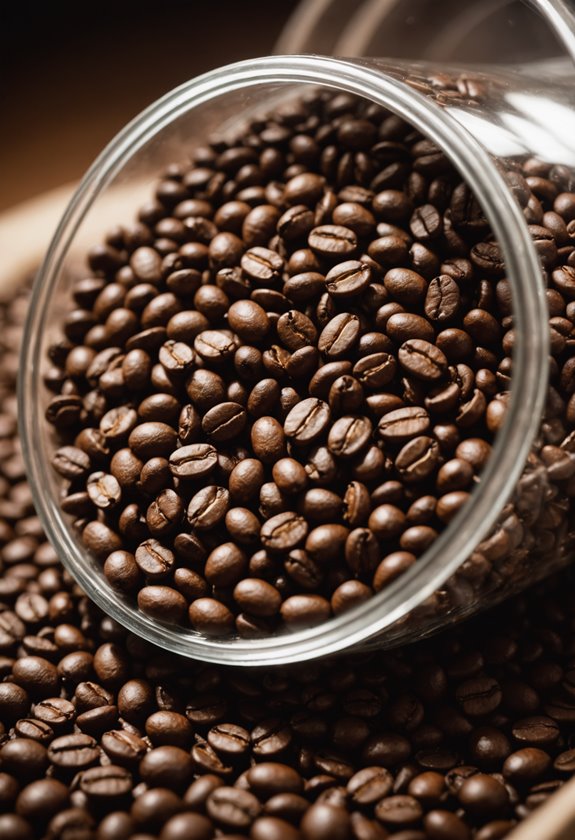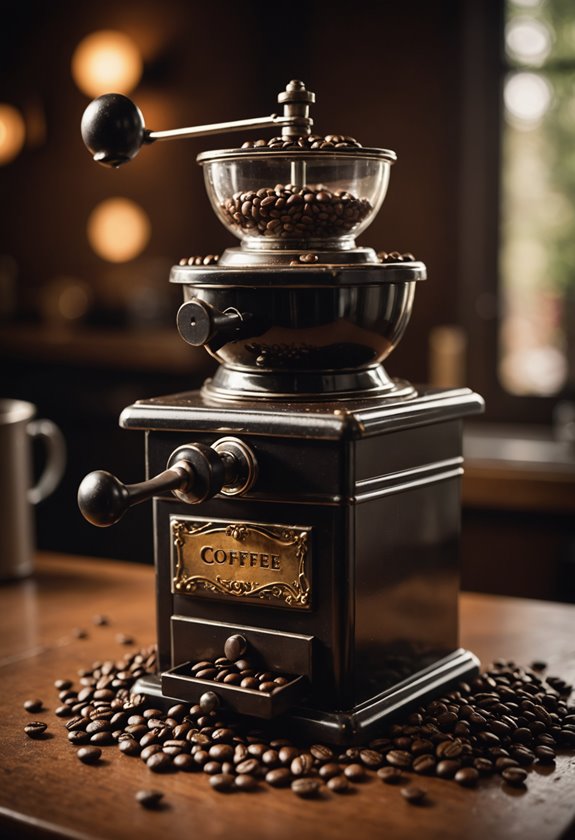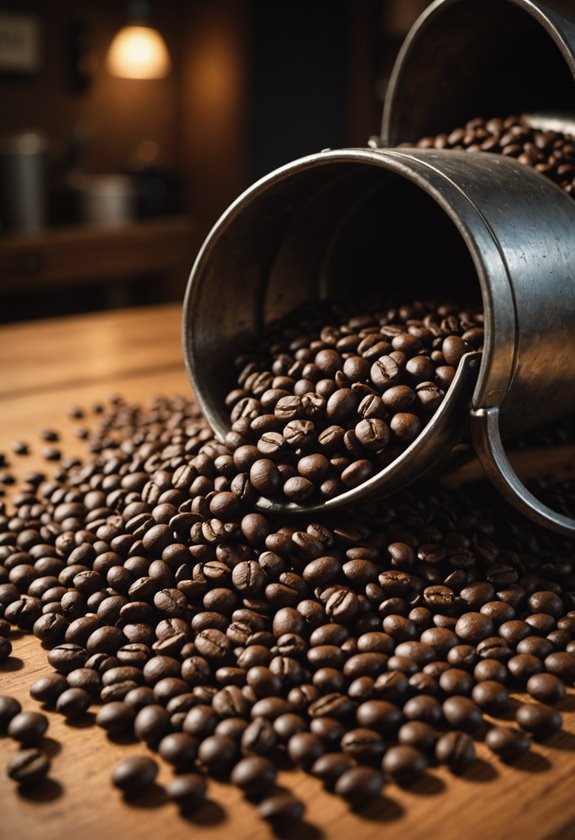How Long Can You Keep Coffee Beans in the Hopper?
You should keep coffee beans in the hopper for only 1-2 days to maintain their freshness and rich flavor. Air and light exposure are your beans' greatest enemies, as oxidation happens quickly once exposed. You see, when beans sit in clear hoppers, light degrades their quality, and frequent opening lets in more air, speeding up the staleness process. For ideal taste, only fill the hopper with what you'll use immediately. Remember, grinding just before brewing helps capture the full aroma and taste. Let's examine how you can best store your beans to savor that enjoyable coffee experience longer.
Key Takeaways
- Limit coffee bean hopper time to 1-2 days to ensure freshness.
- Oxidation begins within hours, degrading coffee quality quickly.
- Use opaque hoppers to protect beans from light exposure.
- Fill hoppers only with the amount needed for immediate use.
- Regularly grind beans shortly before brewing to maximize flavor.
Understanding Coffee Bean Freshness

When you're diving into the world of coffee, understanding the freshness of your beans is vital. Freshness is key to revealing the rich flavors and aromas that make coffee so enjoyable. Coffee beans, when fresh, have a lively taste profile, but they begin to lose their freshness quickly due to oxidation. Leaving beans exposed to air for several hours can significantly degrade their quality.
Once roasted, coffee beans should ideally rest for about a week. This resting period helps in achieving peak flavor by allowing gases to escape and the beans to stabilize.
Storing Your Beans Properly
To maintain the freshness of your coffee beans, it's important to store them correctly. An airtight container is your best friend here. By storing your beans in such a container, you prevent exposure to air, which slows down the oxidation process. Some coffee enthusiasts opt to freeze their beans for long-term storage, though this requires careful handling to avoid moisture damage. This keeps your roasted coffee beans tasting fresh for a longer time.
The Role of Your Coffee Grinder****
Using a coffee grinder just before brewing guarantees you get the most out of your beans. Grinding releases aromatic compounds and oils that enhance flavor.
This is why freshly roasted beans, when ground right before brewing, deliver the best taste experience. So, remember to keep your coffee beans fresh and grind them just before brewing for maximum enjoyment!
Effects of Air and Light
Storing your coffee beans properly is just the start; you also need to take into account the effects of air and light on your beans. Oxygen exposure in hoppers causes oxidation, which quickly degrades both the flavor and aroma of your coffee beans. Within just a few days, this process can lead to a noticeable decline in taste.
Light exposure, especially from clear hoppers, further accelerates the breakdown of essential flavor compounds, leading to staleness.
Managing Air Exposure
Frequent opening of hoppers introduces air and moisture, both of which compromise coffee freshness. This air exposure encourages oxidation, making it vital to limit how often you open the hopper. Water temperature plays a crucial role in extracting the best flavors from your beans when brewing.
Consider using airtight containers to store any extra beans, reducing the air exposure they face.
Combating Light Exposure****
Light exposure, particularly from direct sunlight or strong indoor lighting, affects coffee beans greatly. It speeds up staleness, making your coffee taste flat.
To combat this, keep your hoppers away from bright light sources or use opaque hoppers to shield your beans.
For the best coffee experience, grinding just before brewing ensures maximum freshness and flavor retention.
Optimal Hopper Usage Time

To maintain the freshest and most flavorful coffee, limit the time beans spend in the hopper to just 1-2 days. By doing so, you guarantee the beans remain as fresh as possible, preventing the undesirable effects of oxidation that occur when coffee beans are exposed to air. Oxidation starts degrading the quality within just a few hours, leading to a loss of flavor and aroma.
Understanding Hopper Limitations
Hoppers, typically clear and not airtight, expose coffee beans to light and oxygen, increasing the risk of staleness. To combat this, only fill the hopper with the amount of beans needed for immediate use. This practice helps maintain that sought-after freshness, assuring that your freshly ground coffee has the best possible taste.
Monitor and Store Wisely
Keep coffee beans fresh by storing them in airtight containers when not in use. This approach minimizes their exposure to air, preserving their quality over time.
Regularly monitor the freshness of your beans and grind them shortly before brewing. This simple step can appreciably enhance your coffee experience, providing a rich, flavorful cup every time.
Let's investigate these practices to enjoy peak coffee quality.
Best Storage Practices
While maintaining the freshness of your coffee beans, proper storage practices are vital. To keep your roasted coffee fresh and flavorful, you need to manage how you store beans in hoppers. Exposure to air and moisture accelerates oxidation, which diminishes the quality of your brew.
Here's how you can guarantee your beans stay fresh:
- Use Airtight Containers: Always store excess beans in sealed containers to prevent air exposure.
- Limit Hopper Time: Keep beans in hoppers for no more than 1-2 days to minimize oxidation.
- Avoid Frequent Opening: Each time you open your hopper, it allows air in, speeding up staleness.
- Rotate Stock: Implement a rotation system so older beans are used first, maintaining consistent freshness.
- Consider UV Protection: Use hoppers with UV protection to shield beans from light degradation.
Let's investigate why these practices are significant.
Airtight containers will keep your beans from losing aroma and flavor. Limiting time in hoppers guarantees minimal exposure to air and moisture, while rotating stock guarantees the oldest beans are used first, giving you consistently fresh coffee.
Signs of Stale Beans

Ensuring your coffee beans remain fresh requires attention to storage practices, but recognizing when beans have gone stale is equally vital.
Let's investigate the signs of stale coffee beans that can affect your brew's quality.
Thinner Extraction and Reduced Crema****
When you keep the coffee beans in the hopper for a long period, you might notice a thinner extraction, leading to a watery espresso.
This often results in a reduced crema, indicating the beans have aged and lost their freshness.
Freshly roasted beans usually produce a rich crema, so any decline suggests it's time to reflect on a fresh bag of beans.
Flat Taste and Oxidation****
A flat or bland taste is another telltale sign.
You might describe it as uninteresting or dull, often due to oxidation.
This chemical process occurs when beans are exposed to air, causing them to lose their lively flavors over time.
Diminished Aroma and Rancid Oils****
Stale beans often have a diminished aroma, which is an essential component of an enjoyable coffee experience.
Additionally, if you notice rancid oils on the beans, they've likely surpassed their ideal freshness period.
These oils can give your brew unpleasant, paper-like undertones, further diminishing your coffee's quality.
Frequently Asked Questions
Is It Okay to Leave Coffee Beans in a Grinder Hopper?
Leaving coffee beans in a grinder hopper isn't ideal. Exposure to air and light causes oxidation, making them stale. To maintain freshness, store beans in airtight containers and only keep enough in the hopper for a day or two.
Can I Leave Beans in the Hopper?
You can leave beans in the hopper, but try to limit it to a day or two. After that, air and moisture can degrade freshness, leading to stale flavors. For the best taste, use beans quickly.
How Long Can Coffee Beans Sit in a Grinder?
You shouldn't let coffee beans sit in a grinder for more than 1-2 days. Exposure to air causes oxidation, degrading flavor. For the best taste, grind only what you need immediately after roasting and before brewing.
Are 2 Year Old Coffee Beans Still Good?
You shouldn't use two-year-old coffee beans. They're stale, losing essential flavors and aromas. While they won't harm you if stored well, their taste is flat and unappealing. Fresh beans offer the best coffee experience.
Conclusion
To maintain your coffee's rich flavor, keep beans in the hopper for no more than two days. Air and light can quickly degrade their quality, leading to stale, lackluster brews. Use airtight containers for storage, keeping beans in a cool, dark place to preserve freshness. Check for signs of staleness, like a dull aroma or flat taste, to guarantee the best coffee experience. By following these tips, you'll enjoy delicious, fresh coffee every time.







